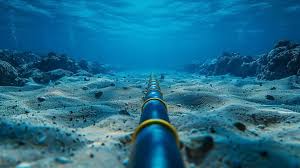In our interconnected world, where information flows seamlessly across continents at the speed of light, it’s easy to overlook the intricate infrastructure that makes it all possible. At the heart of this digital revolution are underwater cables, the lifelines of the internet. In this blog, we’ll take a deep dive into the world of underwater cables, exploring their history, technology, importance, and the challenges they face.
History of Underwater Cables:
The story of underwater cables dates back to the mid-19th century when the first transatlantic telegraph cable was laid across the Atlantic Ocean in 1858. This groundbreaking achievement revolutionized long-distance communication, reducing the time it took to send messages from weeks or months to mere hours.
Over the decades, advancements in technology have transformed these cables from simple telegraph lines to sophisticated fiber-optic systems capable of transmitting vast amounts of data at incredible speeds. Today, a complex network of underwater cables spans the globe, connecting continents and enabling the seamless flow of information that powers our modern world.
Technology Behind Underwater Cables:
Modern underwater cables consist of optical fibers enclosed in protective layers designed to withstand the harsh conditions of the ocean floor. These fibers, made of glass or plastic, carry digital signals in the form of light pulses, allowing for high-speed data transmission.
The cables are typically laid by specialized ships equipped with advanced equipment for seabed mapping, cable deployment, and maintenance. Before installation, meticulous planning and route optimization are conducted to ensure the most efficient and reliable connectivity between endpoints.
Importance of Underwater Cables:
The importance of underwater cables cannot be overstated. They serve as the backbone of global communication, enabling internet connectivity, international phone calls, financial transactions, and the transmission of vast amounts of data essential for businesses, governments, and individuals worldwide.
Without these cables, the internet as we know it would not exist in its current form. They facilitate real-time collaboration, support e-commerce, enable remote work, and connect people across continents, fostering cultural exchange and global interconnectedness.
Challenges Facing Underwater Cables:
Despite their critical role, underwater cables face various challenges that can impact their reliability and performance. One major challenge is the threat of damage from external factors such as fishing activities, ship anchors, natural disasters, and geological events like earthquakes and submarine landslides.
Another challenge is the need for regular maintenance and repairs, as cables can degrade over time due to environmental factors and wear and tear. Maintenance operations often require specialized equipment and skilled personnel, adding to the complexity and cost of maintaining underwater cable networks.
Additionally, underwater cables are vulnerable to cybersecurity threats, including hacking attempts, sabotage, and espionage. Protecting these critical infrastructure assets requires robust security measures and international cooperation to mitigate risks and ensure the continued integrity of global communications.
Future Trends and Innovations:
Looking ahead, advancements in technology promise to further enhance the capabilities of underwater cables. Researchers are exploring new materials for cable construction, such as carbon nanotubes, that offer improved durability and performance.
Furthermore, innovations in artificial intelligence (AI) and data analytics are being leveraged to optimize cable routing, predict maintenance needs, and enhance network security. These developments are essential for meeting the growing demand for high-speed, reliable internet connectivity in an increasingly digital world.
In conclusion, underwater cables are the unsung heroes of the internet, playing a crucial role in enabling global connectivity and communication. Their evolution from simple telegraph lines to cutting-edge fiber-optic systems reflects the relentless march of technological progress.
As we continue to rely on digital technologies for work, education, entertainment, and more, the resilience and reliability of underwater cables become ever more important. By understanding and appreciating the complexity of these underwater lifelines, we gain a deeper appreciation for the interconnected world we inhabit and the remarkable infrastructure that supports it.
Contact Linden Photonics to get a quote or Call Us at (978) 392-7985

